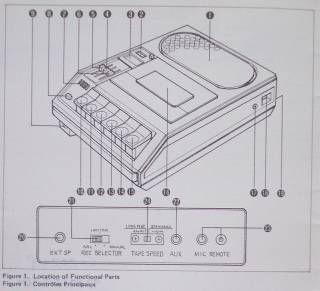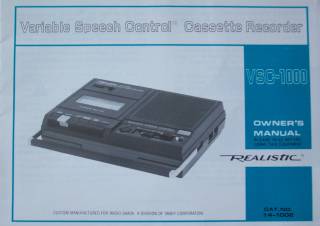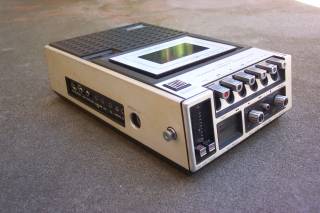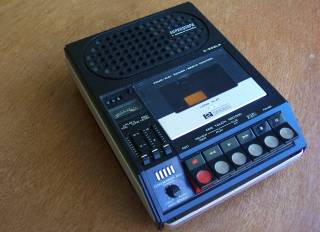 |
 |
Ferric-oxide Archaeology
A survey of audio cassette player manipulation techniques in live performance,
1977- 91
Ernie Althoff
This article describes some of the cassette related signal processing techniques devised and used by Melbourne composers and performers of experimental music, in addition to cassette player use for just on-stage playback (p/b). The decade 1975-85 could be seen as a high point, with cassette technology now well developed, inexpensive and well integrated into ordinary, non-academic, society. Music journal articles from the period mention these features, placing cassettes comfortably into a sociopolitical, music-making framework [1] [2] . Various works demonstrating techniques are listed as examples, but neither they, nor the techniques themselves, should be seen as definitive.
1. Cassette players as scored instruments
Composers wrote cassette parts into often-complex scores. New notations were often necessary to accommodate the instructions therein. Systems of PLAY, PAUSE, RECORD, REWIND, speed and volume levels, and other possibly detailed operations were mostly arranged along calibrated time-lines (pre-dating similar digital usage), or arranged in sequences for works depending on more chance-based processes."cassette CASSETTE" (Ernie Althoff, 1979), for one string performer and fourteen cassette player 'technicians', is a 37-minute work where the technicians sit around the string performer in a loose arc; recording, rewinding and playing back at set volume levels according to their parts. A second example is "Cassenoisette" (Rainer Linz, 1989), for four operators of the sliding pitch controls (as well as the PLAY, PAUSE and volume functions) of four Realistic VSC-1000 machines. The machines are loaded with tapes of 'Futurist' noises, and the glissandos are definitely in a post Grainger/Kangaroo-pouch genre.
2. Pause button replaces razorblade
The speed and dexterity of access to cassette machine buttons (especially the metal ones on quality machines such as the Superscope range), as well as their keyboard-like line-up, leant them readily to a live performance context. Compare them with the three or four axis gear-shift on any lower priced reel-to-reel machine (clunk-clunk) for ease of manipulation. The chance to do 'live edits' with these tools made new compositional procedures available. Most machines were pretty responsive too: the PAUSE was usually quite sharp. And if it wasn't, well, that opened up more doors!"Uncopyrightables" (Althoff, 1985) features a text read onto two cassette loops at breakneck speed. fragmented in real-time by a PAUSE foot pedal into one machine and a hand-held on/off switch on a $2 microphone into the other. A single stereo microphone feeds the voice into both machines simultaneously, but the two PAUSE controls inefficiently cut up the text in different ways, inserting lots of weird little gliss-squeaks and other noises.
Place two or more machines together in a room. Set both (or all) on PLAY: you get a mix. Place some to the front and some at the back: you get reverb, panning and spatial presence. With a cardboard tube over the speaker you get filtering and more reverb. Move your palm quickly over the speaker: you get wah-wah. Now put one machine into RECORD while the others are in PLAY: you get material reiteration and room resonance addition (Do this six times or more and you get Alvin Lucier's results - even with cheap cassettes!). Play identical tapes on two machines for phasing. Add new material, e.g. an acoustic sound source not yet used in the work: you get overlays with different levels of clarity. Ron Nagorcka said in a 1978 C.A.E. class on electronic music: "With two cassette players one has a highly effective and inexpensive portable sound studio". He's right. Add a few more, and you'll never exhaust the compositional possibilities.
3. Multi-tracking without a mixer
Several machines playing together were often used. Incidentally, it was so much easier and far less costly to set up an array of twelve cassette players across a space for a multi-track mix, as Bill Fontana did with "Vending Machine Sculpture" (1977), than to do the same work with as many reel-to-reel decks (or even pro-quality recording tape run through a sixteen channel mixing desk). Purists may say the sound is inferior; I say it's not inferior, just different!The room resonance addition phenomenon has been mentioned above. Despite this effect, Graeme Davis made the most beautifully clean mixed tapes for later live performance use. He would set up several mono machines in his work room late at night with their tapes cued and their volume levels set. Also in the room was his JVC stereo cassette recorder with two microphones, set up for recording. Everything (players and recorder) was plugged into the same power board. With the power off at the wall, all machines were switched on. When the switch at the wall was thrown, everything started at once. From hearing the quality of his tapes, people found it hard to believe he used such a 'primitive' system. In the work "Love is a Beautiful Song" (1980), six tapes made in this fashion are played as a background for two performers of prepared wind instruments [3] .
4. Changing position
Altering the location of the cassette player and its recording microphone with respect to the sound source alters the signal's volume, resonance, clarity, and balance with the other sounds of the performance. In one version of the work "Somnambulism" (Nagorcka, 1978), two performers gradually move a number of cassette players away from a small playing harmonium, its selected keys weighted down with fishing sinkers. As the machines travel across the floor, a score of PLAY, REWIND and RECORD functions is carefully followed. When the work is performed in a larger space, the movement system is reversed in a more radical, and more theatrical, way. Gordon Monahan's technique of speaker swinging is employed with a p/b machine, and recording machines are placed at the perimeter of the speaker's circular path. The score also calls for the p/b cassette to be replaced by a recording cassette at times, necessitating a scuttling movement as one of the performers ducks in under the swinging speaker. The work has also been performed with the speaker swinging as a linear pendulum and recording machines placed in a line under it.5. Tape loading in non-linear sequence
The classic example here is "Atom Bomb" (Nagorcka, 1977) for two performers, voices, small percussion instruments and four cassette players starting with tapes wound to their finish. Carefully detailed scores and counting systems instruct the performers to rewind the tapes and record fragments, then rewind again, loading the four tapes in reverse order. The work's final movement consists of the four machines being placed in the room's corners, where they replay the material in a complex mix, mirroring the earlier part of the performance [4] [5] [6] .Of course, there's always the simpler 'rewind and punch-in' process for altering a time sequence. A large number of works feature this technique. Another device that needs mentioning here is the cassette tape loop. The TDK Corporation made robust endless tape loops in various lengths from 20 seconds to 12 minutes. A box of these became an integral part of many a performer's kit. Soon cheaper loops for telephone answering machines appeared on the market (mostly from the Tandy Group) and, to the composers' delight, featured new durations. Loops added another dimension to Nagorcka's 1978 statement. Now, when one did Lucier-type room resonance works, one didn't need to rewind anymore! Again, the availability of a product opened new compositional areas.
6. Superscopes and varispeed
In the mid-seventies, Marantz brought out the Superscope range of cassette machines - the ultimate Prince of Portables (There may have been better, pro-quality units, but they were totally prohibitive in price). The original, metal-cased C-104 and C-105 machines had exquisite buttons and superb responses. The C-105 had three heads, so simple p.a. functions (and even feedback) were possible. Best of all though was the inbuilt varispeed function which operated in p/b mode. This meant that pitch could be altered 20% each way, and glissandos: just twist the knob! Bounce this new signal around in Nagorcka's two-machine 'studio' and endless potential emerges! The paired works "Accentuate the Positive" and "Eliminate the Negative" (Althoff, 1979) use this set-up with two 20-second loops, voice as the instrument, and a set of shuffled flashcards as the score in each work. Sounds are layered up when one machine in RECORD captures the voice plus the speed- and pitch-altered voice from the other machine. "Positive" ends with a huge babble of voices in many different pitches and drawls. "Negative" takes this process a little further. The performer pretends to load more words onto the loops, but in reality the microphone is switched off (in later models the manual RECORD level is slid to zero), erasing a neat hole in the loop. This happens again and again, leaving just a few stray utterances that struggle persistently on, to finally fade to silence.In 1980, the new Superscope models outdid themselves. Yes, the metal cases were replaced by rugged plastic, but features, features, features! The C-202LP featured volume, tone and manual RECORD level sliders, a single button RECORD, CUE and REVIEW with sound, a killer PAUSE , a limiter and an A.R.L. setting, mini-jacks for extension speaker, aux, external microphone and external PAUSE , a phono headphone jack, a good internal microphone, a legible VU meter, a 15% each way varispeed knob (p/b only) AND a half-speed switch! This gave a total pitch modification range of from 42% up to 230%, depending on what speed setting one used when recording. The only thing missing was noise reduction, but at around $120 in 1980, who cared? Did the Marantz company, which intended these machines for use in field journalism, ever consider what a magnificent tool it had provided for the world of experimental electronic music?
7. Feedback
Always a handy tool for adding thickness and colour to a texture, feedback was easy with cassette machines. Plug in an extension speaker and an extension microphone, or use the inbuilt microphone. Open the cassette compartment lid, and manually push down the rear left lever as you set the machine into RECORD . This is the lever that is usually controlled by the break-out plastic tabs on the tops of cassette bodies (No tab = no record). Place the speaker and microphone in the correct proximity to get the type of feedback you want. Simple! Added timbral sophistication comes with using contact microphones on metal sheets (or even A4 paper), placing the speaker/microphone pair into metal, PVC or cardboard tubes, or even building a large multi-machine feedback processor. Althoff's work "Seven out of Eleven" (1985) uses a device where two small external speakers are plugged into the speaker and microphone jacks (a speaker will work as a microphone, and vice versa) and set up facing each other. A 3 cm wide strip of flexible cardboard is inserted between the two speaker cones, providing an arched bridge for the vibrations to cross. Moving the speakers slightly alters the flexion of the bridge, and hence the characteristics of the feedback signal.8. Customising
Given the versatility of the stock object, it's surprising that people did customise cassette machines, but it certainly occurred. Switches were installed to turn off the erase head, making simple overdubs possible. One could also do this by covering the erase head with cardboard. Warren Burt built a primitive cassette delay device using two Sanyo machines that had no sides to their cassette compartments, and a special two-body cassette tape he made, where the tape ran out of one housing, over the two p/b heads, and into the second housing. The further apart the machines, the longer the delay. Unfortunately, the two slightly different motor speeds often pulled the tape apart. In August 1986, visiting U.S. composer Richard Lerman demonstrated his version of this idea, this time built with two Sony WM-D6C Pro-Walkmans with speed adjustment and line-outs to an amplifier. For "Cassettes Are Driving Me Crazy!" (1979), Davis took the plastic case off a machine, and into this now-nude unit pushed copper wire to hold back the pinch roller. This, of course, produced a huge amount of bizarre speed and pitch fluctuations (WOW is not the word for it!) in both RECORD and p/b modes. "Our Electronic Heritage" (Althoff, 1980) was an improvisation on a 'self-playing' cassette-less machine, where a father had repaired the loose plastic case of his daughter's cassette player by drilling a hole through its corner and inserting a long threaded bolt and nut to hold things firm. Yes - right through the circuit board! Unwittingly, he'd made an electronic instrument that could be played by pressing various buttons, turning knobs and by shaking it. The cassette p/b function still worked, so a mix was possible too.9. Head in hand
In 1991, Davis performed the work "Tracing" at the Linden Gallery, St. Kilda, using a most radical form of cassette technology customisation. He'd built a hand-held 'pen' with a cassette recording head at its end, connected by a cable to a small amplifier. The other part of the sound producing system was a 'picture' on an easel: a picture made of recorded cassette tape carefully pasted in precise rows on a sheet of plywood about 35 cm square. Davis slid the pen over the picture, thereby broadcasting the taped information. Pen speed (pitch control), direction (forward and backward), pen pressure (volume and distortion), movement or not (on/off), movement across the strips rather than along them (fragmentation) - all were controlled by hand gestures. Compare this process with Laurie Anderson's on her tape-bow violin: somehow similar, but with Davis's the motion is transferred to the other component and is a little more versatile (Nam Jun Paik had also used a moving tape-head device in performance in the 1960s; though his, like Anderson's, was for 1/4-inch tape.).10. The conceptual approach
In 1985, NMA Publications released the cassette "The Way I See It", a work by Althoff featuring a text layer of 60 instructions to the listener on how to alter and affect their listening experience, emphasising that control was theirs, was always theirs, and that listening be seen as a responsibly active experience [7] . Suggestions ranged from the technical to the theatrical to the downright silly! At three points in the work, the voice suggested to switch off the tape now, to never listen to the rest of the work, and to be forever intrigued with the mystery of the unheard material. So solidly is this work embedded in the cassette medium, the idea of transferring the work to a digital CD format seems totally pointless!Postscript
Note how all this activity occurred long before Australians heard of the U.S. based "Cassette Mythos" movement and its anthologies published in the early 1990s. This may well be yet another example of similar practices being devised at similar times but in different communities - history is liberally sprinkled with such occurrences. A more cynical approach would look at Australian and American social stereotypes, and the strangely modifying role of the publicity machine. Hopefully, this article may help to redress the circumstances.In the mid-1980s, Sydney composer Rik Rue perfected techniques for the use of the four-track Tascam Portastudio as a live performance instrument. The rock 'n' roll world already used these machines in studios and bedrooms on which to make demo-tapes. Rue had also long been an advocate of the cassette as a music tool - a context he called "Pause Culture". He became adept in both solo and ensemble formats, delighting interstate and eventually overseas audiences with his style, sensitivity and dexterity and wit. More composers bought four-track machines, and began composing works specifically for their use in a performance context. A new era dawned for a while...
Footnotes
- Nagorcka, R. "Exciting possibilities for real-time composition using your old and tinny cassette recorder". The new music newspaper, No. 3. University of Melbourne Music Faculty. January 1978. p.16. return
- Burt, W. "Cassettes - Warren lists a few of the advantages". The new music newspaper, No. 3. p.18. return
- Burt, W. "Seven composers in three parts". Art Network, No. 6. Art Network, Sydney. July 1982. pp.36-38. return
- Nagorcka, R. "Atom Bomb (score)". The new music newspaper, No. 1. August 1977. p.8-9. return
- Kenny, R. "Atom Bomb and Son and Godzilla". The new music newspaper, No. 3. p.17. return
- Nagorcka, R. "Atom Bomb (excerpt)". Cassette track. NMATAPES 2. NMA Publications. Melbourne. 1983. return
- Althoff, E. "The Way I See It". Cassette. NMA Publications. Melbourne 1985. return
Further reading
- Althoff, E. "The Clifton Hill Community Music Centre, 1976-83". NMA 7. NMA Publications. Melbourne 1989. pp.39-43. (available online )
- Jenkins, J. 22 contemporary Australian composers. NMA Publications. Melbourne 1988. (available online )
- Brophy, P. & D. Chesworth (eds) New Music Nos. 0-4. CHCMC. Melbourne. 1979-80.

